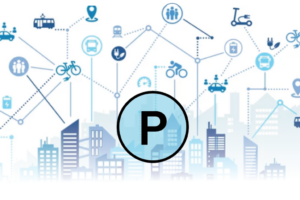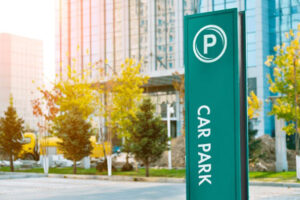By Chris Scheppmann
The urban transportation landscape is rapidly changing, with ride sharing services becoming ubiquitous and self-driving vehicles on the horizon. No longer do most travelers drive themselves to a parking facility near their ultimate destinations; today they are just as likely to be dropped off by an Uber or Lyft driver right at the curb in front of their destination.
This trend has had a significant impact on downtown traffic, cluttering the curb with unmanaged vehicle movement and creating an unsafe environment for drivers and pedestrians alike. And curbs will become even more cluttered when self-driving vehicles begin to populate our streets in significant numbers, dropping off their passengers and then taking off.
In fact, over the past two years we have already begun to experience these changes because of the Covid-19 pandemic. At the height of the initial wave of Covid, restaurants and stores introduced curbside pickup to serve their customers (and to survive). In many neighborhoods curbsides are now more like a free-for-all, with drivers pulling up wherever they like for however long they want. The proliferation of self-driving vehicles will just exacerbate this already serious issue.
A Technological Solution
The answer to these new curbside pressures can be found in Intelligent Camera Technology. Intelligent Camera Technology leverages the latest advancements in vison-based software technology to provide accurate and affordable curb management. The cameras monitor curbside activity in real time, analyzing what types of vehicles are using the curb and for how long, and transmitting that information to a cloud-based platform that determines whether each vehicle’s use of the curb is appropriate.
The heart of the curb management suite is specialized software that constantly receives data from curbside cameras and analyzes that data in real-time. The software manages a host of essential curb-related tasks, including TNC monitoring,…
By Geoffrey Garnier
What does the city of tomorrow look like?
The city of tomorrow, which calls itself “smart,” will implement connected solutions (thanks to sensors, artificial intelligence, Internet of Things, etc.) that will collect a set of usable and concrete data to make the best possible decisions.
The benefits for these cities are multiple: first, it allows them to improve the engagement of public authorities and citizens by providing solutions that involve them and offer them a better quality of life. But also, to solve their environmental problems with solutions that are ecologically oriented.
Cities are therefore more connected, efficient in their decision making and eco-responsible.
North American cities are particularly ahead of the curve on this smart city concept with the aim of improving their productivity as well as their connectivity. Many of them have joined the Cities for Climate Protection™ campaign organized by the UN, which commits them to implementing eco-responsible solutions to promote the climate transition. Of the 650 participating municipalities, nearly half are North American: 159 are American and 133 are Canadian.
Some sobering parking figures…
95%, 17h, 900,000 tons… But what do these numbers correspond to? These figures are all related to parking and are the results of different studies around the world:
- 95%? The time that a private vehicle remains in a parking space. (International Parking Institute, Why parking matters, 2015)
- 17h? The average time a typical user spends looking for a parking space over the course of a year. And that same average is 107 hours in New York. (INRIX, The Impact of Parking Pain in the US, UK, and Germany, 2017)
- 900,000 tons? Greenhouse gas emissions that can be avoided through smart parking solutions. (Köln auf dem Weg zur Smart City, 2017)
These figures can be thought-provoking.
Indeed, parking lots are very often neglected and little…
Bill Smith
When is a parking solution not about solving a parking problem? It may surprise you to find out that parking garages can also provide solutions to non-parking challenges facing building owners.
Cell phone coverage poses unique challenges in urban high rise residential and commercial buildings. It can be difficult to provide consistent service throughout high-rise buildings, particularly in underground parking areas. The deeper the underground parkade—the tougher it is to provide consistent cell service.
And the problem is only getting worse. The latest cellular standard, “5G”, operates at very high frequencies and doesn’t penetrate buildings as easily as previous generations of Cellular did. While 5G may be great if you’re sitting in your car downtown, you may not be so lucky in areas with less direct sightlines.
Traditionally, developers and building owners have had to install distributed antenna systems ‘DAS’ to provide consistent cell service in their buildings. A distributed antenna system is a network of separated antenna nodes connected to a common source to provide wireless service throughout a structure or geographic area. DAS technology is effective but very expensive—a system can cost hundreds of thousands of dollars to install in a single building. And with cellular technology changing so rapidly, there’s no guarantee that these
DAS systems will continue to work with each new generation of cellular technology. That’s a lot of financial risk for a building owner to take on. The challenge is particularly acute in underground parking facilities, where 5G is particularly unreliable.
A Parking Solution
That was the challenge facing Goddard Investment Group in Dallas. Fountain Place, an office building owned by Goddard Investment, was ready for a cell upgrade that would extend reliable cell service into the building’s underground parkade. But the prospect of spending hundreds of thousands of dollars on technology that may…
By Ravali Kosaraju, PE, PTOE
In some corners of the parking industry “mobility” is considered a dirty word. For some professionals who have devoted their careers to finding new ways for people to park conveniently and safely, the current emphasis in mobility is off-putting.
In fact, though, parking and mobility are intrinsically connected. Mobility isn’t meant to replace parking; it’s meant to collaborate with it. In fact, as counterintuitive as it may seem, parking is an essential element of mobility.
To understand this, it’s first necessary to take a step back and look at what mobility really is. Mobility is the essential element of urban life. It’s about access. Access to the things people need to live a healthy and rewarding life. Access to friends and relatives, healthcare and other essential services, entertainment, shopping options, work, and recreation opportunities. Transportation is an element of mobility, but it’s not the totality of mobility. Rather, mobility is about having high quality transportation options.
What makes mobility options “high quality”? First is choice. Do residents and visitors have multiple transportation options? Are there opportunities to use their personal vehicles, access ride-share servicers, utilize public transit, and take advantage of micromobility? Is the community pedestrian friendly? Having a single transportation option isn’t conducive to mobility.
Time is also a key element. If it takes too long to go to and from destinations in a community, because of traffic or because there are too many stops on a bus line or subway line, you don’t have mobility. No one wants to spend hours to get to a grocery store and back, or from work and back.
Finally, safety is a key element of mobility. If it isn’t safe to walk, drive, take public transit, or bike you don’t have mobility.
So, transportation doesn’t equal mobility. You must offer…
By Cynthia Bruce
Whether you are an experienced procurement specialist or you simply have a small lot you want to start generating revenue with, getting the most out of your interactions with a parking technology supplier starts with asking the right questions.
Making sure that you have enough information to even ask those questions in the first place often means putting out a Request for Information (RFI) and letting the responses guide how you will subsequently write a Request for Proposals (RFP). For smaller jobs or where an existing relationship is being leveraged, you may get all the information you need from a Request for Quotations (RFQ).
I will start by briefly summarizing the differences between these types of documents, so you know which is best for you before going on to discuss what to look for in the responses you receive from proponents.
Which RFx is right for you?
RFIs, RFPs, RFQs (and all their ilk) all serve different purposes and become progressively more specific, so which you choose will depend on the information you have and the information you still need.
Questions to consider before making a decision might include some of the following:
- Do you have any existing parking equipment and/or technology? Does it need to be replaced, or are you adding on to your existing solution?
- Are you working with an existing vendor?
- Are you required to go through a formal RFP process?
- Are you unsure of your needs and therefore have general questions?
- Are you asking specific questions because you know exactly what you want?
How you answer these questions will determine how your team seeks out a parking operations contractor.
Request for Information
When you are ready to find a…
By Shreeras Shetty
Parking meters are gaining immense traction in various countries across the globe, owing to the significant surge in traffic congestion by vehicles and surging need for parking meters to manage parking spaces. There has been an expeditious growth in the number of vehicles across the globe, which further drives the demand for parking meters in the coming years. Parking meters are extensively installed in high traffic, commercial, and healthcare places including the hospitals, government institutions, malls & stadium, public parks, and others. Thus, with the COVID-19 restrictions eased-off, more people around the globe are tending to attend various functions, concerts, malls, stadiums, and others. This is expected to drive the demand for parking meters in the coming years.
Moreover, public infrastructures such as libraries, tourist attraction places, transit stations, civic buildings, universities, and others generate an immense parking demand. Hence, parking meter comes out as an effective solution towards reducing the traffic and managing parking spaces. In addition, municipalities are extensively using parking meters particularly for mobility management policies and on-street parking policy regarding the traffic. Persistent technological advancements in parking meters, introduction of creative products, and integration with innovative technologies are expected to provide lucrative opportunities for the growth of the global parking meter market.
Growing prevalence of IoT-based technology that provides solutions while looking for a parking space is remarkably augmenting the installation of pioneering and effective parking management solutions. Further, these factors are expected to provide tremendous opportunities for the growth of the global parking meter market in the upcoming years. According to a report published by Allied Market Research, the global parking meter market is expected to grow expeditiously in the coming years.
Numerous players in the market are devising innovative strategies to add supplementary features in the…
By Melissa Tucci
A parking lot is often your customers’ first and last interaction with your facility and can therefore have a direct and memorable impact on their overall satisfaction with the experience. The parking operation should be clean and safe, and the equipment you use to control access and generate revenue from parking should be functional and appropriate to the task.
Each parking lot has a unique set of conditions that all need to be addressed in designing a solution – not only what types of parkers you want to attract or deter, but what means are at your disposal to finance the operation.
Some items to consider include:
- Capital costs
- Installation costs
- Maintenance costs
- Operational costs
- Projected revenues
- Life expectancy
- Updates and certification versus forklift upgrades
Capital costs
Gated parking systems are more expensive not only because more equipment is required — terminals and barriers at the entrance and exit, pay stations, servers, etc. — but the equipment itself is more complex.
Multi-space meters in ungated parking lots, by contrast, require only the meters themselves, which are usually less expensive to begin with. They can more easily be offered on an all-in rental basis, eliminating the need for capital purchase. As some parking operators upgrade their systems from ungated to gated systems, an increasing number of refurbished multi-space meters are available on the market, providing a unique opportunity for smaller businesses and municipalities to launch a paid parking program using certified equipment.
Installation costs
Installing gated systems requires a great deal of design and engineering. You’ll need to take into consideration how cars will approach and queue at the entrance and exit gates.
The terminals and gates will need to be mounted on concrete islands….
By: Jeffrey Dea, Vice President, Business Development, Toronto Parking Authority
The International Energy Agency reports that, despite a pandemic disrupted and turbulent year, sales of Electric Vehicles (EV) broke all records in 2021, and there is no sign this trend is waning in 2022.
From innovative battery technology to new EV models hitting the roads, there is no question that the stage is set for the EV market to reach its true potential and transform the way we travel. However, Toronto still faces a significant barrier to progress in this market – the lack of a comprehensive and publicly accessible EV charging network.
As adoption takes hold, EV owners will demand a charging network that offers simplicity, speed, choice, and ease of use. Toronto Parking Authority (TPA) is an important ingredient in meeting consumer demand in this regard, and our vision to become the world’s best provider of sustainable parking, bike share, and last-mile mobility experiences, strategically positions us to be a catalyst for EV adoption. We strive to meet our customers’ expectations every day, and we see our role in the transition to EV as an exciting opportunity, but there is no time to spare.
The increase in EV ownership is creating a demand that we need to meet now. In addition, the City of Toronto’s TransformTO Strategy, launched in 2017, calls for a reduction in community-wide greenhouse gas (GHG) emissions in Toronto to net zero by 2040 – 10 years earlier than initially proposed. The strategy establishes 2030 goals that will see 30 percent of all registered vehicles on the road be electric and 75 percent of school/work trips under 5 km either walked, biked, or taken by transit.
Aligned with the global push for sustainability measures, Toronto’s net zero strategy is ambitious, and…
First, A Mobility Wallet is Needed, Then Some Drive.
By Gabe Klein, Partner at Cityfi
Mobility What?
For the past 5 years, I have tried to get anyone that would listen, particularly in the mobility and real estate space to think about the importance of a “mobility wallet.” Back in pre-pandemic 2017, I was working in West Palm Beach on the Downtown Mobility Plan with the city’s Mayor, Assistant City Manager, Head of Transportation, and a slew of great consultants. As we were meeting with the planning department, local developers, the Downtown Development Authority, and others, it became clear that there was a need to productize and simplify the mobility offerings in the city from the County’s transit services (Palm Trans) to the cities Circulator Trolley, the bikeshare system and so forth. The city’s first planned microunit development was also being planned (it did not come to fruition), which spurred the conversation, “Why are we going to build parking spaces that are the same size as the units themselves?” We then realized that changing zoning was (and is) hard but writing new zoning specifically for microunits was very practical and could require an alternative to building parking. But what would that be?
Like a game of telephone, I now realize that there are many variations of what a “mobility wallet” means, and what it can do for our communities. In the original context, we envisioned creating an environment where instead of a developer funding many millions of dollars in new parking, we would entice (carrots) and require them in some cases (sticks) to alternatively fund a mobility wallet for every household in their apartment building, with $150-$200+ of free mobility services including unlimited transit, bikeshare and some number of rides on Brightline rail, a ride…
By Susanne Tedrick
Cloud computing has changed how people and organizations consume information technology products and services. Given the cloud’s flexibility and agility, organizations were able to use cloud services to continue mission critical operations and allow employees to work from home. According to Flexera’s 2021 State of The Cloud report, 36% or enterprise respondents said that they expect to $12M or more in cloud services, and 90% of enterprise respondents expected that their cloud usage would exceed their prior plans because of the pandemic.
This sped up cloud use and spending has caused some additional challenges, particularly around having skilled resources. According to a recent study by the information technology research firm Gartner, many IT leaders said that they lack in-house skills to manage 60% of their current operational tasks (particularly in the areas of security, dev ops, networking, and compliance), and over 50% felt that in 2022, they won’t meet their company’s cloud adoption goals because of a lack of in-house skills and experience.
Now more than ever, having cloud computing knowledge and skills is important. If you’ve never heard of cloud computing or are not entirely familiar with the concept, here’s ten things you should know:
1. Cloud computing is not a new concept. At a top level, cloud computing is the delivery of information technology resources over the internet. Rather than purchasing and maintaining computer hardware and software, you “rent” services from someone else.
While the term cloud computing is relatively recent, the underlying concept of cloud computing dates back all the way to the 1960’s. IT was then that computer scientist J.C.R. Licklider came up with an idea for an interconnected system of computers called ARPANET (Advanced Research Projects Agency Network) that laid the groundwork for what would eventually become what…













